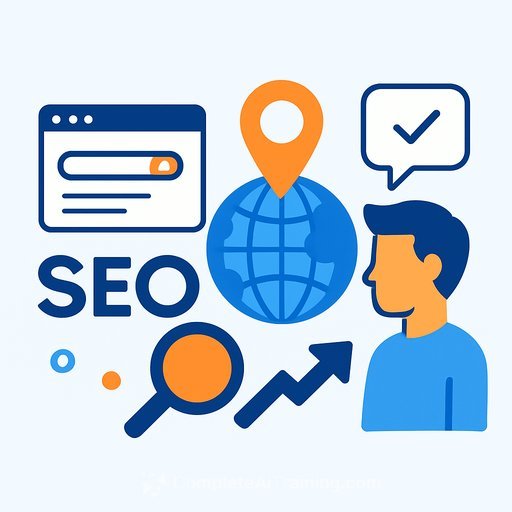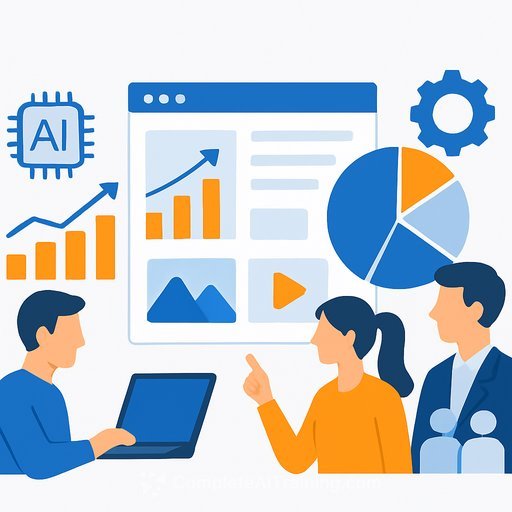This week in advertising: platforms race ahead, publishers pay the bill
Platforms pushed hard on autonomous shopping, AI creative, and measurement. Publishers stared at the math: millions of pages scraped, just $174 earned from AI crawlers. Privacy controls tightened, lawsuits escalated, and holiday automation took center stage.
If you lead budget, growth, or media, the signal is clear: automate ruthlessly, measure incrementality, hedge against search volatility, and prepare for privacy turbulence.
Holiday automation: Google vs. Meta
Google's November "Drop" for Demand Gen adds brand suitability controls across YouTube Home, watch next, and Discover. Three inventory modes give you tighter control over adjacency (Standard, Expanded, Limited). Asset-level experimentation lets you systematize creative testing, with Google pushing a compounding math case: small monthly gains stack into outsized returns.
- Pick an inventory mode per brand risk profile. Default to Standard; move to Limited for stricter guidelines.
- Run weekly asset tests and force decisions. Track a rolling log of winners and redeploy quickly.
- Lean into short-form video and AI image automation for faster creative velocity.
Meta dropped festive guidance centered on Advantage+ automation (reporting a 22% ROAS lift in 2025). They're fully consolidating into Advantage+ structures, with legacy campaign APIs deprecated and migration due by Q1 2026. Prep was split into Q3 testing and Q4-Q5 execution, with shopping peaks in late Nov and early Dec.
- Consolidate structures to Advantage+ now; protect learning phases and simplify signals.
- Document Q3 tests → Q4 execution rules. Don't rewrite mid-flight unless data forces it.
- Lock your migration plan for Q1 2026 to avoid breaking automations during peak promo cycles.
Autonomous shopping rolls out, but frictions remain
Google introduced agentic checkout (auto-purchase on price drops), Duplex calls to verify local inventory, and conversational shopping inside Search and Gemini. The Shopping Graph now spans 50B+ listings with 2B hourly updates. Early merchant access includes Wayfair, Chewy, Quince, and select Shopify sellers.
Adoption isn't guaranteed. Retailers have reasons to resist intermediated buying, return rates are high, and many shoppers still want to compare before committing. Treat agentic shopping as a test lane, not a forecast.
- Flag high-intent SKUs for price-drop automation and ensure feed accuracy (price, stock, variants).
- Clarify merchant eligibility and payment integration; pressure-test fulfillment and returns.
- Adjust attribution to capture auto-checkout events that won't follow legacy click paths.
Measurement: cheaper incrementality and MMM alignment
Lift testing minimums dropped to $5,000 with faster reads and stronger models. Available now for Video, Discovery, and Demand Gen; Display/Search/Shopping/PMAX need rep coordination. This puts statistically sound testing within reach for more brands.
- Schedule monthly lift tests. Predefine confidence thresholds, sample sizes, and go/no-go rules.
- Test lifecycle bidding (new vs. existing customers) and validate with lift, not last-click myths.
- Feed experiment outcomes into MMM. Use Google's Meridian (Bayesian) framework to calibrate models with real experiments.
Technical and supply chain updates
Google published crawler specs covering heuristic HTTP caching (ETag/If-None-Match, Last-Modified/If-Modified-Since), content encoding (Brotli, Gzip, Deflate), and protocols (HTTP/1.1, HTTP/2, HTTP/3 with QUIC). If SEO and engineering haven't talked about crawl budget, server load, and cache headers recently, schedule it.
DV360 renamed exchanges in reporting: Magnite Streaming → Magnite SpringServe, Xandr → Microsoft Monetize, Criteo-Commerce Grid → Criteo Commerce Grid. Update saved reports, dashboards, and any supply-path automations tied to exchange names.
Search volatility and Gemini 3
Search saw a "Movember" spike around Nov 7, and more swings near Nov 20. Some speculate Gemini 3 models are being threaded into systems. With num=100 disabled, tool visibility dropped; teams are relying more on direct traffic and revenue signals.
- Audit thin location pages and add real-world signals (addresses, local content, hours, unique value).
- Track SERP feature share, not just rank. Prioritize queries where you still earn clicks.
- Diversify demand: email, social, creator, affiliates, and retail media to offset search volatility.
AI Mode now taps Gemini 3 for richer reasoning and generative layouts, including interactive visuals. Feedback is mixed: impressive outputs, but creator concerns around content reuse intensify. Google is testing larger "double-check important information" disclaimers on AI Overviews.
On creative, Nano Banana Pro (built on Gemini 3 Pro) lands in Search and Ads. Expect better brand alignment via reference images and stricter adherence to guidelines. Also note: Google added more countries to its offline gambling ad restrictions list.
Privacy and legal: a new off-switch and platform lawsuits
Google agreed to build an RTB Control that strips identifiers from bid requests for opted-out Google account holders. No cookies, IPs, device IDs, user agents, or encrypted IDs. It's opt-out, not default, and still pending court approval with the earliest hearing in January 2026.
If codified, expect pressure for similar controls elsewhere. Translation: less deterministic programmatic scale and more reliance on modeled measurement, 1P data, and contextual supply.
- Scenario-plan for identifier loss: protected audience buys, contextual, and PMPs with clean room measurement.
- Strengthen value exchanges for logged-in users and server-side tagging to preserve signal ethically.
- Audit partners for data minimization and compliance guardrails now, not after the switch flips.
Separately, Google/YouTube and Meta filed federal lawsuits challenging California SB 976's limits on personalized feeds for minors. Platforms are asserting editorial rights and access-to-speech arguments. Expect more legal pressure shaping feed and ad personalization settings in the U.S.
Publisher economics: AI crawlers and the $174 problem
One publisher earned $174 from AI crawlers after millions of page hits. Content costs are real; compensation isn't. A handful of big outlets cut licensing deals, but most haven't seen a cent.
- Quantify crawler load and bandwidth cost. If negative, tighten robots/headers or pursue licensing.
- Shift dependency away from open-web pageviews: newsletters, podcasts, events, paid communities.
- Experiment with affiliate, commerce, and high-intent landing pages less exposed to zero-click erosion.
Streaming and alternative browsers: new metrics and new models
Netflix switched from MAUs to MAVs (Monthly Active Viewers), reporting 190M globally. MAVs reflect co-viewing and some ad exposure outside traditional ad-supported plans. Your reach models should reflect households and co-viewing realities, not just account counts.
Brave generated $25M in Q1 2025, largely from search ads on its own index. Combined with a recent ruling that Google must share some index data with rivals, it's a reminder that privacy-first and contextual models can sustain real revenue at smaller scale.
Display budgets shift: open web pressure intensifies
Forrester expects brands to cut open web display spend 30% in 2026, reallocating to CTV and paid social. Agencies report similar cuts already this year. Advertisers are chasing channels with clearer measurement and shoppable formats.
- Pre-plan 15-30% reallocation scenarios into CTV, retail media, and paid social. Insist on incrementality tests.
- Pilot interactive and shoppable video with clear product feed connections.
- With publishers, buy outcomes: branded content tied to first-party signal and commerce, not just impressions.
Forbes rolled out an AI-powered dynamic paywall after a 40% drop in search referrals. Expect more inventory moving behind subscription walls, tightening open-web reach and forcing smarter partnership buys.
EU Digital Omnibus: simplification with side effects
The EU published its Digital Omnibus, aiming to cut administrative burden by 25% overall and 35% for SMEs by 2029. It could clarify rules for data use and AI training while changing operating latitude for platforms and ad tech. Plan for compliance gains in some areas and tighter guardrails in others.
Read the Commission's overview.
What to do this week
- Google Ads: set brand suitability by placement, launch asset-level tests, and track compounding returns.
- Meta: consolidate into Advantage+ structures and lock your API migration plan.
- Measurement: book a $5k lift test for December; calibrate MMM with results.
- Search: harden local and product pages; monitor SERP feature share, not just rank.
- Privacy: audit identifier dependencies; draft an RTB Control contingency plan.
- CTV: line up Q1 shoppable pilots with clear incrementality guardrails.
- Publishers/Partners: review crawler costs; negotiate usage or enforce access limits.
Timeline
- Nov 7: Google expands brand suitability to YouTube Home, watch next, Discover; search volatility spike ("Movember").
- Nov 11: Incrementality minimums drop to $5,000.
- Nov 13: Agentic checkout and AI shopping launch; Google/YouTube and Meta sue California over SB 976.
- Nov 14: Forbes rolls out AI dynamic paywall to all readers.
- Nov 16: Meta releases festive season guidance (Advantage+ focus).
- Nov 17: Google's Demand Gen "Drop"; DV360 exchange renames; Google agrees to RTB Control settlement terms.
- Nov 18: AI Mode begins Gemini 3 rollout; Performance Max campaign total budget goes live.
- Nov 19: AI Mode officially powered by Gemini 3; EU Digital Omnibus published; offline gambling ad list updated.
- Nov 20: Google crawler documentation updated; Nano Banana Pro released; $174 publisher crawler revenue surfaces; more search volatility.
- Nov 21: Larger "double-check important information" disclaimer tested in AI Overviews.
- Also: Forrester projects 30% cut to open-web display in 2026; Netflix shifts to MAVs at 190M; Brave posts $25M in Q1 2025.
Level up your team
If you're building skills around AI-driven media buying, creative automation, and measurement, explore:
Your membership also unlocks:






